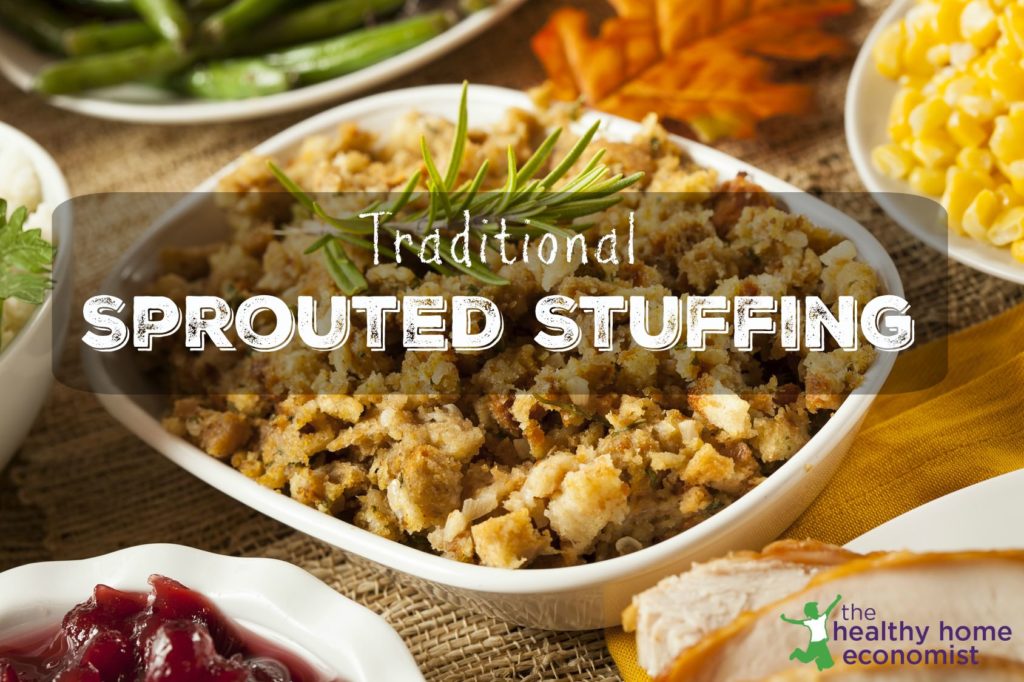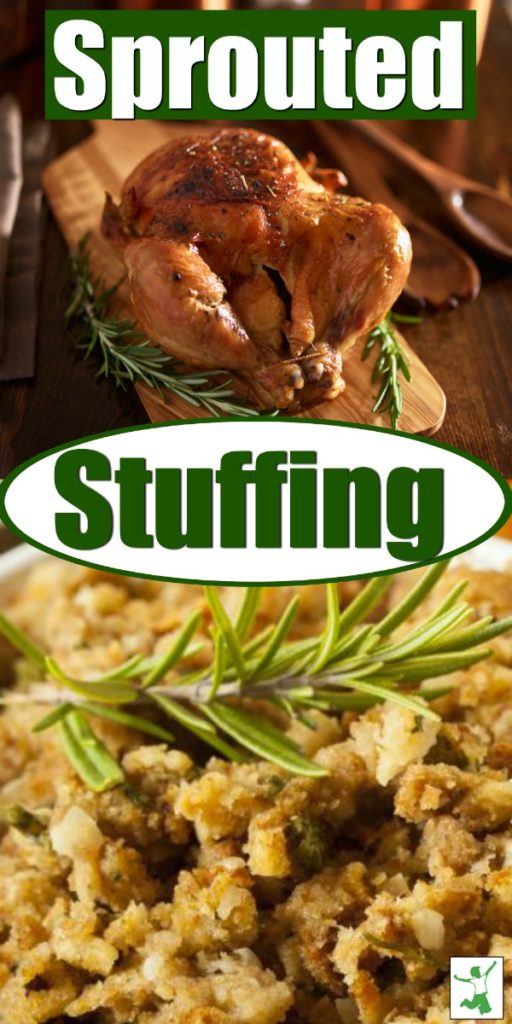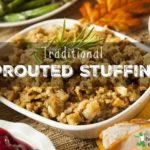Table of Contents[Hide][Show]
Digestible, nourishing stuffing recipe made with sprouted bread in accordance with traditional practices that is a healthy addition to your holiday meal.

For many people, choosing the perfect stuffing recipe is critical to the success and full enjoyment of a holiday meal. The challenge is making this very important side dish in a manner that is easily digestible for all. This includes a gluten-free option for guests that might have an intolerance to this hard to digest plant protein.
If you choose to prepare a stuffing based on bread, the most digestible choice is whole grain baked traditionally. This means the grains were either sour leavened (sourdough) or sprouted prior to baking.
Unfortunately, the emphasis of conventional nutritionists to consume whole grains is without caveat. This is neither complete nor optimal advice. Traditional societies never prepared their whole grains in modern fashion as quick rise yeasted bread, granolas, pasta, and other rapidly cooked grain dishes. Moreover, they did not consume grain-based foods in excessive quantities like today.
Traditional cuisines and pre-industrialized peoples from around the world took great care to soak, sprout and/or ferment their grains before consuming them. Prior to the introduction of commercial yeast, used to make bread rise quickly, Americans and Europeans alike made slow rise bread from fermented dough starters. (1)
Such bread is commonly known as sourdough (but watch out for fake sourdough!)
How to Make Healthy Stuffing
Science has demonstrated the wisdom of these careful preparation methods. All grains and legumes contain phytic acid, an organic acid that blocks mineral absorption in the intestinal tract. Grains also contain lectins, another group of anti-nutrients.
As little as 7 hours of soaking neutralizes phytic acid. Water forms the base with small amounts of an acidic medium such as lemon juice or cider vinegar. Simple cooking or baking deactivates lectins. Soaking also neutralizes enzyme inhibitors present in the hulls of all seeds. The process also adds beneficial enzymes that increase the nutrients present especially natural B vitamins.
For those with gluten intolerance, soaking or sprouting gluten-based grains breaks down this difficult-to-digest plant protein. This is important even for nonhybridized forms of wheat such as einkorn or heirloom wheat varieties like farro.
Traditional prep also significantly improves the digestibility of gluten-free grains such as millet and teff too. Even if gluten is absent, plenty of anti-nutrients such as phytic acid can still be present.
Fermentation accomplishes the same. In some cases, this thoughtful preparation permits the consumption of grains even gluten-containing ones without triggering autoimmune symptoms.
Homemade Stuffing Recipe
When choosing the traditional preparation technique where the bread will be used for stuffing, I have found that sprouted bread produces the best results. Sourdough works well too, but not quite as well.
My husband always makes the stuffing, dressing and homemade gravy for our holiday meals. I thought I would share his recipe for sprouted stuffing in case this is something you would like to try to improve the digestibility and nutrient density of your Thanksgiving feast.
I recommend that you cook your turkey filled with sprouted stuffing in a (covered) charcoal grill. The slightly smoky flavor is amazing and it roasts quite a bit faster this way than in an oven.
If you would like to serve this grain-based dish along with a grain-free keto stuffing option to satisfy the dietary needs of your holiday guests, check the link for the recipe!


Traditional Sprouted Stuffing Recipe
This digestible, nourishing stuffing recipe made with sprouted ingredients is a healthy addition to your holiday meal that won’t leave you feeling sluggish.
Ingredients
- 1 loaf of sprouted (or authentic sourdough) bread or equivalent in crusts
- 1/2 lb (225 grams) butter preferably grassfed
- 1 yellow onion medium size, finely chopped, preferably organic
- 1 clove garlic pressed
- 6 sticks celery finely chopped, preferably organic
- 1/2 tsp sea salt
- 1/4 tsp black pepper
- 6 bay leaves
- 1/8 tsp thyme
- 1/8 tsp sage
- 1/8 tsp oregano
- 1/8 tsp sweet basil
- 1/2 cup raisins optional
Instructions
-
Melt butter in small saucepan at low heat. Crumble bread into breadcrumbs or use food processor (this is the one I have).
-
Mix all dry ingredients together in a large mixing bowl. Thoroughly mix in onion, garlic, celery. Add melted butter and mix to completely distribute butter throughout.
-
You may use this mixture either as stuffing (inside the turkey) or as dressing (in a pan cooked separately).
-
Stuffing: Firmly pack handfuls of the mixture into turkey cavity and enclose and cook inside turkey until turkey is done. While turkey is resting after roasting, remove stuffing from cavity and place on serving dish.
-
Dressing: Fill bread pan with mixture and press down firmly with hands to create an inch or two of a gap between top of dressing and top of bread pan. Bake with or without turkey for 60 minutes (preferably at 325F/160C) and remove. It should be golden brown on top and moist but not wet inside.
Recipe Notes
Do not use any types of Ezekiel sprouted bread as they contain vital wheat gluten, a potent anti-nutrient and cheap additive.
A loaf of sourdough bread or the equivalent in crusts may be substituted for sprouted bread as desired.
Alternatively, contact the Weston Price Foundation for a copy of its annual Shopping Guide for a list of artisanal bakers that will ship to your door.








How much does this recipe make?
I don’t know. Never measured it. But consider that it involves a whole loaf of sprouted bread. It easily feeds our family of 5 with plenty of leftovers.